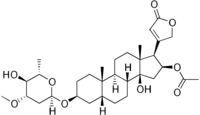- Glycoside
-
In chemistry, a glycoside (pronounced /ˈɡlaɪkəsaɪd/) is a molecule in which a sugar is bound to a non-carbohydrate moiety, usually a small organic molecule. Glycosides play numerous important roles in living organisms. Many plants store chemicals in the form of inactive glycosides. These can be activated by enzyme hydrolysis,[1] which causes the sugar part to be broken off, making the chemical available for use. Many such plant glycosides are used as medications. In animals and humans, poisons are often bound to sugar molecules as part of their elimination from the body.
In formal terms, a glycoside is any molecule in which a sugar group is bonded through its anomeric carbon to another group via a glycosidic bond. Glycosides can be linked by an O- (an O-glycoside), N- (a glycosylamine), S-(a thioglycoside), or C- (a C-glycoside) glycosidic bond. The given definition is the one used by IUPAC, which recommends the Haworth projection to correctly assign stereochemical configurations.[2] Many authors require in addition that the sugar be bonded to a non-sugar for the molecule to qualify as a glycoside, thus excluding polysaccharides. The sugar group is then known as the glycone and the non-sugar group as the aglycone or genin part of the glycoside. The glycone can consist of a single sugar group (monosaccharide) or several sugar groups (oligosaccharide).
The first glycoside ever identified was amygdalin, by the French chemists Pierre Robiquet and Antoine Boutron-Charlard, in 1830.[3]
Related compounds
Molecules containing an N-glycosidic bond are known as glycosylamines and are not discussed in this article. (Many authors in biochemistry call these compounds N-glycosides and group them with the glycosides; this is considered a misnomer and discouraged by IUPAC.)
Chemistry
Much of the chemistry of glycosides is explained in the article on glycosidic bonds. For example, the glycone and aglycone portions can be chemically separated by hydrolysis in the presence of acid. There are also numerous enzymes that can form and break glycosidic bonds. The most important cleavage enzymes are the glycoside hydrolases, and the most important synthetic enzymes in nature are glycosyltransferases. Genetically altered enzymes termed glycosynthases have been developed that can form glycosidic bonds in excellent yield.
There are a great many ways to chemically synthesize glycosidic bonds. Fischer glycosidation refers to the synthesis of glycosides by the reaction of unprotected monosaccharides with alcohols (usually as solvent) in the presence of a strong acid catalyst. The Koenigs-Knorr reaction is the condensation of glycosyl halides and alcohols in the presence of metal salts such as silver carbonate or mercuric oxide.
Classification
We can classify glycosides by the glycone, by the type of glycosidic bond, and by the aglycone.
By glycone/presence of sugar
If the glycone group of a glycoside is glucose, then the molecule is a glucoside; if it is fructose, then the molecule is a fructoside; if it is glucuronic acid, then the molecule is a glucuronide; etc. In the body, toxic substances are often bonded to glucuronic acid to increase their water solubility; the resulting glucuronides are then excreted.
By type of glycosidic bond
Depending on whether the glycosidic bond lies "below" or "above" the plane of the cyclic sugar molecule, glycosides are classified as α-glycosides or β-glycosides. Some enzymes such as α-amylase can only hydrolyze α-linkages; others, such as emulsin, can only affect β-linkages.
There are four type of linkages present between glycone and aglycone:
- C-linkage/glycosidic bond, "nonhydrolysable by acids or enzymes"
- O-linkage/glycosidic bond
- N-linkage/glycosidic bond
- S-linkage/glycosidic bond
By aglycone
Glycosides are also classified according to the chemical nature of the aglycone. For purposes of biochemistry and pharmacology, this is the most useful classification.
Alcoholic glycosides
An example of an alcoholic glycoside is salicin, which is found in the genus salix. Salicin is converted in the body into salicylic acid, which is closely related to aspirin and has analgesic, antipyretic, and antiinflammatory effects.
Anthraquinone glycosides
These glycosides contain an aglycone group that is a derivative of anthraquinone. They have a laxative effect. They are mainly found in dicot plants except the Liliaceae family which are monocots. They are present in senna, rhubarb and Aloe species. Antron and anthranol are reduced forms of anthraquinone
Coumarin glycosides
Here the aglycone is coumarin or a derivative. An example is apterin which is reported to dilate the coronary arteries as well as block calcium channels. Other coumarin glycosides are obtained from dried leaves of Psoralea corylifolia.
Chromone glycosides
In this case, the aglycone is benzo-gamma-pyrone.
Cyanogenic glycosides
In this case, the aglycone contains a cyanide group. In many plants, these glycosides are stored in the vacuole, but, if the plant is attacked, they are released and become activated by enzymes in the cytoplasm. These remove the sugar part of the molecule and release toxic hydrogen cyanide. Storing them in inactive forms in the cytoplasm prevents them from damaging the plant under normal conditions.
An example of these is amygdalin from almonds. They can also be found in the fruits (and wilting leaves) of the rose family (including cherries, apples, plums, almonds, peaches, apricots, raspberries, and crabapples). Cassava, an important food plant in Africa and South America, contains cyanogenic glycosides and, therefore, has to be washed and ground under running water prior to consumption. Sorghum (Sorghum bicolor) expresses cyanogenic glycosides in its roots and, thus, is resistant to pests such as rootworms (Diabrotica spp.) that plague its cousin maize (Zea mays L.). It was once thought that cyanogenic glycosides might have anti-cancer properties, but this idea was disproven (see Amygdalin). A recent study may also show that increasing CO2 levels may result in much higher levels of cyanogenic glycoside production in sorghum and cassava plants, making them highly toxic and inconsumable. A doubling of CO2 concentration was found to double the concentration of cyanogenic glycosides in the leaves.[4][5]
Dhurrin, linamarin, lotaustralin, and prunasin are also classified as cyanogenic glycosides.
Flavonoid glycosides
Here the aglycone is a flavonoid. Examples of this large group of glycosides include:
- Hesperidin (aglycone: Hesperetin, glycone: Rutinose)
- Naringin (aglycone: Naringenin, glycone: Rutinose)
- Rutin (aglycone: Quercetin, glycone: Rutinose)
- Quercitrin (aglycone: Quercetin, glycone: Rhamnose)
Among the important effects of flavonoids are their antioxidant effect. They are also known to decrease capillary fragility.
Phenolic glycosides (simple)
Here the aglycone is a simple phenolic structure. An example is arbutin found in the Common Bearberry Arctostaphylos uva-ursi. It has a urinary antiseptic effect.
Saponins
These compounds give a permanent froth when shaken with water. They also cause hemolysis of red blood cells. Saponin glycosides are found in liquorice. Their medicinal value is due to their expectorant, and corticoid and anti-inflammatory effects. Steroid saponins, for example, in Dioscorea wild yam the sapogenin diosgenin - in form of its glycoside dioscin - is an important starting material for production of semi-synthetic glucocorticoids and other steroid hormones such as progesterone. The ginsenosides are triterpene glycosides and Ginseng saponins from Panax Ginseng C. A. Meyer, (Chinese ginseng) and Panax quinquefolius (American Ginseng). In general, the use of the term saponin in organic chemistry is discouraged, because many plant constituents can produce foam, and many triterpene-glycosides are amphipolar under certain conditions acting as a tenside. More modern uses of saponins in biotechnology are as adjuvants in vaccines: Quil A and its derivative QS-21, isolated from the bark of Quillaja saponaria Molina, to stimulate both the Th1 immune response and the production of cytotoxic T-lymphocytes (CTLs) against exogenous antigens make them ideal for use in subunit vaccines and vaccines directed against intracellular pathogens as well as for therapeutic cancer vaccines but with the aforementioned side-effects of hemolysis.[6]
Steroidal glycosides or cardiac glycosides
Here the aglycone part is a steroidal nucleus. These glycosides are found in the plant genera Digitalis, Scilla, and Strophanthus. They are used in the treatment of heart diseases, e.g., congestive heart failure (historically as now recognised does not improve survivability; other agents are now preferred) and arrhythmia.
Steviol glycosides
These sweet glycosides found in the stevia plant Stevia rebaudiana Bertoni have 40-300 times the sweetness of sucrose. The two primary glycosides, stevioside and rebaudioside A, are used as natural sweeteners in many countries. These glycosides have steviol as the aglycone part. Glucose or rhamnose-glucose combinations are bound to the ends of the aglycone to form the different compounds.
Thioglycosides
As the name implies (q.v. thio-), these compounds contain sulfur. Examples include sinigrin, found in black mustard, and sinalbin, found in white mustard.
See also
- Carbohydrate
- Carbohydrate chemistry
- Natural products
- Glycosylation
- Chemical glycosylation
- Glycorandomization
References
- ^ Brito-Arias, Marco (2007). Synthesis and Characterization of Glycosides. Springer. ISBN 978-0-387-26251-2.
- ^ Lindhorst, T.K. (2007). Essentials of Carbohydrate Chemistry and Biochemistry. Wiley-VCH. ISBN 978-3527315284.
- ^ Nouvelles expériences sur les amandes amères et sur l'huile volatile qu'elles fournissent Robiquet, Boutron-Charlard, Annales de chimie et de physique, 44 (1830), 352–382
- ^ "Cassavas get cyanide hike from carbon emissions - environment - 13 July 2009 - New Scientist". www.newscientist.com. http://www.newscientist.com/article/mg20327163.100-cassavas-get-cyanide-hike-from-carbon-emissions.html. Retrieved 2009-07-13.
- ^ "Staples such as cassava on which millions of people depend become more toxic and produce much smaller yields in a world with higher carbon dioxide levels and more drought". Yahoo.com. July 2009. http://uk.news.yahoo.com/22/20090629/tsc-environment-us-climate-crops-011ccfa.html.
- ^ Hong-Xiang Suna,∗, Yong Xiea,b, Yi-Ping Yec (2009). Advances in saponin-based adjuvants. Vaccine 27 ; pg 1787–1796 doi:10.1016/j.vaccine.2009.01.091
External links
- Definition of glycosides, from the IUPAC Compendium of Chemical Terminology, the "Gold Book"
- IUPAC naming rules for glycosides
Geometry Glycone Aglycone biochemical families: prot · nucl · carb (glpr, alco, glys) · lipd (fata/i, phld, strd, gllp, eico) · amac/i · ncbs/i · ttpy/iCategories:- Carbohydrate chemistry
- Glycosides
Wikimedia Foundation. 2010.


